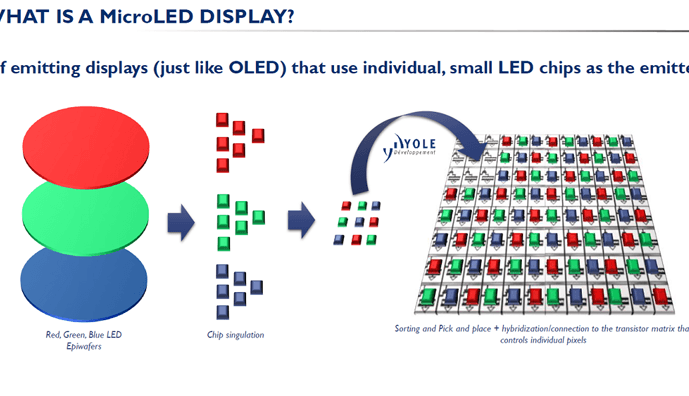MicroLED displays?
September 20, 2017
on
on

The march of technology is relentless; no sooner had we become used to LCDs when along came improved versions offering LED back-lighting, OLED technology has more recently taken over large-format display applications such as televisions. Even the latest iPhone X, due to deliver at the end of the month, uses an OLED display. As always the latest technology carries a price premium and OLEDs have yet to infiltrate every display application but already we hear news that the next generation of displays using MicroLED technology is just over the horizon...
The quality of the displays used for today’s smart devices is very impressive. Smartphone ‘Retina displays’ with their small diagonal dimensions already achieve better than HD resolution, TVs with UHD displays are now almost standard issue and the first models with 8K resolution are already being manufactured. Not only the resolution, but also the properties of the individual pixels are very precise. Displays using OLEDs offer enormous contrast, high viewing angle stability and low power consumption. You might even be tempted to think that the technology could hardly be improved upon.
Well of course you would be wrong: thanks to the enormous advances in semiconductor fabrication techniques, it is now possible to reduce the dimensions of conventional non-organic LEDs to such an extent that they can be used to build the highest resolution color displays. A display built with this technology offers even more advantages: in addition to the extreme contrast and high viewing angle stability of OLEDs, they can also achieve higher switching speeds and improved efficiency giving significantly lower power consumption. The display properties also degrade less quickly over time. At the moment these MicroLED displays are still work in progress. New processing techniques are being refined to produce smaller displays. According to YOLE, we will need to wait at least until 2019 before we see the introduction of the latest AppleWatch (version 4?) using such a high-tech display.
The quality of the displays used for today’s smart devices is very impressive. Smartphone ‘Retina displays’ with their small diagonal dimensions already achieve better than HD resolution, TVs with UHD displays are now almost standard issue and the first models with 8K resolution are already being manufactured. Not only the resolution, but also the properties of the individual pixels are very precise. Displays using OLEDs offer enormous contrast, high viewing angle stability and low power consumption. You might even be tempted to think that the technology could hardly be improved upon.
Well of course you would be wrong: thanks to the enormous advances in semiconductor fabrication techniques, it is now possible to reduce the dimensions of conventional non-organic LEDs to such an extent that they can be used to build the highest resolution color displays. A display built with this technology offers even more advantages: in addition to the extreme contrast and high viewing angle stability of OLEDs, they can also achieve higher switching speeds and improved efficiency giving significantly lower power consumption. The display properties also degrade less quickly over time. At the moment these MicroLED displays are still work in progress. New processing techniques are being refined to produce smaller displays. According to YOLE, we will need to wait at least until 2019 before we see the introduction of the latest AppleWatch (version 4?) using such a high-tech display.
Read full article
Hide full article


Discussion (0 comments)